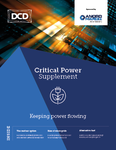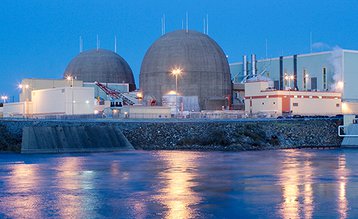Data centers are facing an energy crunch. They want to expand massively, while moving towards net-zero emissions. They need low-carbon electricity, and that’s not always available.
In Hong Kong, for instance, there simply isn’t enough renewable energy for the state, let alone proposed new data centers. Meanwhile in Ireland, there’s a limited amount of green power. If data centers guzzle it all, there’s not enough left to decarbonize sectors like heating and transport, and the country misses its overall net-zero target.
Nuclear positives
Nuclear power could be part of the answer. It produces little or no greenhouse gas emissions, and could potentially deliver energy wherever it is needed.
More importantly, compared with truly renewable sources such as solar and wind energy, nuclear power delivers a steady dependable base load which doesn’t rely on the sun shining or the wind blowing. That’s exactly the kind of power data centers need.
In the past nuclear power has suffered from poor delivery, with giant projects lumbering on amidst huge delays and cost over-runs, while environmental groups campaign vocally against them.
Nuclear states in Europe, like France and Belgium, have succeeded in having nuclear energy classified as a clean technology, because it delivers steady base load electricity, without making greenhouse gas emissions.
However, those countries with existing nuclear power have a problem. As older plants come to the end of their life, governments are unwilling to commit to giant nuclear projects that may or may not succeed.
The alternative seems to be a different way to do nuclear, known as small modular reactors (SMRs). These are intended to overcome the past drawbacks of giant nuclear projects: they are a manageable size, and are built from pre-approved designs, with components made in factories.
In principle, they could be delivered quickly and repeatably. Permitting could be done once, for the design, which can be delivered to multiple places. Components can then be shipped from the factories for construction on-site.
And since their power capacities are smaller than the older giant plants, they could be commissioned for individual projects, or anchored by data center customers.
Nuclear upgrades
The UK is one of the strongest backers of SMRs, with plans to spend up to £20 billion over 20 years, developing a fleet of power plants that could cover up to a quarter of the country's electricity consumption.
Rolls-Royce is one of the leaders, with SMRs that are at 470MW, at the top end of the range of “small” plants. Rolls-Royce plans to install 16 of its SMR generators in the UK
Meanwhile, with Government encouragement, a range of other potential builders are lining up. US-based developer Last Energy has announced a deal to sell 24 small modular nuclear reactors (SMRs) to UK customers.
Last is planning pressurized water reactors (PWRs) each of which will deliver 20MW of power each, and cost $100 million (£78m).
Other SMR companies pitching to build in the UK include Newcleo, a London-based startup that has announced plans to raise £900 million to build small lead-cooled fast reactors. Other firms pitching for money include GE Hitachi Nuclear Energy, GMET Nuclear, Holtec Britain, UK Atomics, and a partnership between Cavendish Nuclear and X-Energy.
Meanwhile, in the US, NuScale is the front runner, with the Voygr system, which has received government support in the form of $4.2 billion in subsidies, and now has approval from the Nuclear Regulatory Commission (NRC) for deployment in the US.
NuScale has published more information than some of the other systems, and earlier this year got some negative publicity. The company had promised to deliver power at $55 per MWh, which made it a good long-term bet against other forms of energy. As details of the system have emerged, the expected cost has crept up to $90 per MWh, even when backed by further funding from the Inflation Reduction Act, the US program which includes measures to promote a transition to low-carbon power.
That’s more expensive than renewable sources such as solar and wind - although nuclear does provide a reliable, continuous energy supply.
Moving in
If nuclear continues to look like a valuable option, there’s a problem: with strong memories of Chernobyl and Fukushima, who wants a nuclear power station in their backyard?
It seems likely that the first SMR reactors will be installed on existing nuclear sites, where the infrastructure and permitting is already in place - and where there may soon be vacancies.
The older generations of nuclear power plants have been running for years. Some are coming to the end of their life.
Those sites already have permissions for nuclear plants, and all the apparatus to transfer the energy into the grid, and the local population have come to appreciate the jobs and energy they provide.
Rolls-Royce is starting the ball rolling with a decommissioned nuclear plant in Trawsfynydd in Wales, which could hold two 470MW systems.
In Canada, Ontario Power Generation (OPG) is building up to four new SMRs in Darlington, Ontario where it currently has four forty-year-old CANDU reactors being refurbished.
OPG’s new SMRs are GEH's BWRX-300 models coming from GE Hitachi and they are due to start delivering power in 2028. They may actually provide power to data centers, as OPG has signed a Power Purchase Agreement (PPA) with Microsoft, most of which will be fulfilled by wind and solar - but nuclear may enter the mix if it arrives in time.
First nuclear data center?
The US has seen the first explicit plan for nuclear-powered data centers - albeit one which won’t come to fruition for more than ten years.
Green Energy Partners (GEP) believes it has found the perfect location: an existing nuclear facility in Virginia run by the Virginia power utility Dominion, close to a hub where a massive expansion in data center capacity is straining the ability of the grid to provide any kind of energy - let alone clean power.
Westinghouse built two 800MW pressurized water reactors 50 years ago in Surry County, on the James River, near Jamestown. The company planned two more PWRs on the site, but they haven’t arrived, though the original reactors have had their licenses renewed to continue till 2052.
Surry is around 200 miles from the Northern Virginia data center hub where Loudoun County in particular is bursting at the seams, with data centers consuming around 20 percent of available power, and new builds frequently delayed by power distribution issues.
It’s on the route to the Virginia Beach cable landing station, so potentially a good place to tap national and international Internet traffic - especially given its potential for clean power.
GEP has bought 641 acres of land next to the site and has proposed a lot of data centers there, which will eventually be powered by new SMRs, with green hydrogen for backup power.
Starting in 2024, the developer has plans to build 30 new data centers on the site (totaling 1 gigawatt), which it has dubbed the Surry Green Energy Center (SGEC).
These will initially be powered by the available grid power, but since the site is next door to Surry, the data centers will actually get nuclear power from day one, GEP COO Mark Andrews told DCD.
“The project is a 1-gigawatt hyper-scale data center campus primarily powered by conventional nuclear out the door, so to speak,” said Andrews.
Using revenue from the data centers, GEP plans to develop on-site nuclear power with up to six 250MW SMRs.
With stringent permitting required, it could take 10 to 15 years for the SMR power to start flowing, GEP's VP of strategic development Bill Puckett told Virginia Business.
Nuclear plus hydrogen?
GEP plans to also produce green hydrogen on-site, using a combined system it calls a "green energy machine" or GEM.
There is actually a lot of synergy between nuclear and hydrogen. Pressurized water reactors use water heated well above boiling point, and can provide waste hot water above 400F. The most efficient electrolysis uses very hot water or steam, so the green hydrogen production plant would effectively use the SMRs’ waste heat as well as some of their zero-carbon electricity.
Some of the hydrogen produced can be blended with natural gas and shipped by existing pipelines outside the site, but a lot can be used on-site for generator backup at the data centers.
“As I am sure you are aware data centers require redundancy,” Andrews told us. “Therefore, we have designed the project to utilize natural gas/hydrogen generators running on approximately 10-15 percent hydrogen [for backup], fully convertible to 100 percent hydrogen within the next three to five years.”
When the SMRs are built, they will provide the primary power and conventional nuclear power will become the secondary power source for backup if more than one SMR goes off-line.
The company is planning 35 acres of the SMRs, alongside 20 acres of hydrogen production.
“We have just recently completed the feasibility study period and have gone hard on the Property,” said Andrews.
The SMR vendor is not yet determined, he explained: “We have just begun the next phase, whereby, we are now having discussions with various SMR and hydrogen manufacturing companies. As of this time we have not committed to any specific SMR partner."
However, GEP’s releases say it has been working with the Department of Energy's Idaho National Laboratory, which is also partnering with the US SMR firm NuScale whose Voygr design is built from 50MW modules.
Interestingly, NuScale is already working on a combined nuclear and green hydrogen system with Shell.
Andrews’ reticence may be partly because of the previously-mentioned setbacks at NuScale, whose projected power cost has recently increased, making its energy potentially less competitive.
Alternatively, it seems there are simply a range of possible partners available for nuclear pioneers.






